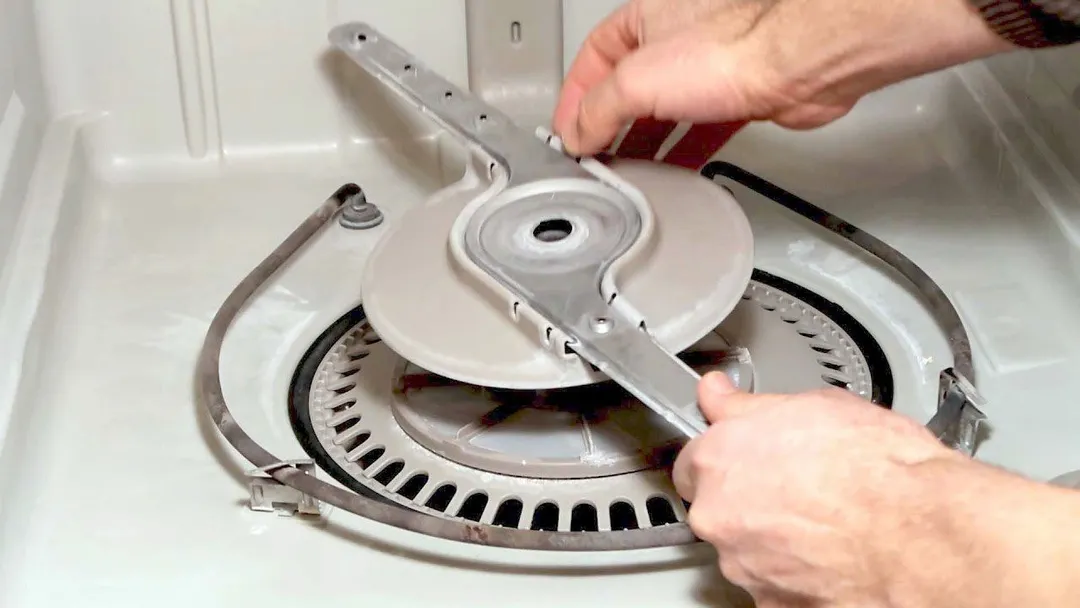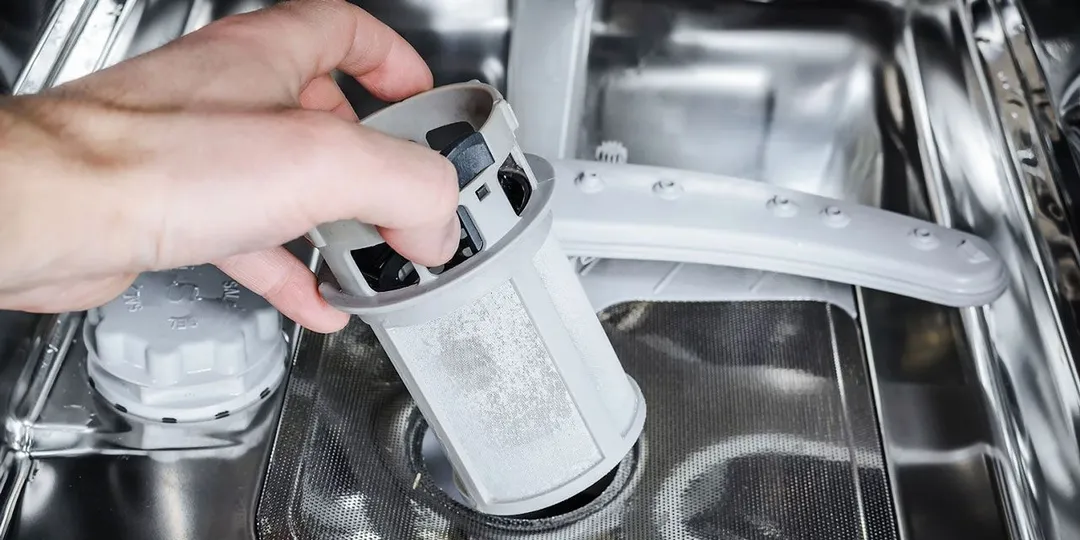Our recommendations are made independently through Research & Testing. We may receive commissions from purchases made via our links.
How to Clean a Dishwasher Filter and Keep Your Dishes Sparkling Clean
If your dishwasher’s filter is broken or dirty, your dishes won’t be clean. In this guide, we’ll show you how to clean a dishwasher filter.
Knowing how to clean a dishwasher filter properly is a lot more important than you may think.
Dishwashers, obviously, are meant to clean things, but one with a dirty filter won’t do its job well. Even after going through a washing cycle, food gunk will still show up on your dishes if the filter doesn’t perform. Understandably, this can lead to a lot of confusion and frustration.
The problematic part is that not many people know how to scrub their dishwasher’s filter. Many don’t even know that dishwashers have filters. People tend to just call a technician to come check it out when the dishwasher acts up.
But here’s the thing: a clogged filter can be fixed very easily, quickly, and more importantly, at no cost.

What Is a Dishwasher Filter? What Does It Do?
The filter is a crucial component that’s present in every dishwasher. When your dishes go through a washing cycle, detergent and water nozzles will wash away the food gunk and debris. With all that gunk dislodged, the machine needs a filter to prevent it from being recirculated with the water and soiling the dishes again.
Needless to say, if the filter runs into problems (clogs, for example), your dishes won’t come out looking very nice. You can keep the filter from being clogged and protect it from other issues by cleaning it regularly.
Self-Cleaning vs. Manual Filters
There are two kinds of dishwasher filters out there: self-cleaning or manual. Depending on your specific type of filter, the maintenance process is going to be different.
Self-Cleaning Filter
If you have a dishwasher that was made before 2010, it’s most likely equipped with a self-cleaning filter (also called a “hard food disposer”).
The filter is quite similar to a sink-based garbage disposal. Its assembly includes a grinder that can pulverize food debris into smaller bits so that they can be easily washed down the drain.
This type is really convenient since you don’t have to clean or maintain it obsessively like a manual filter. Since it’s built quite durably, such a filter can easily last all throughout the dishwasher’s lifespan with minimal check-ups.
There are two downsides. If it ever has a malfunction, you will need to call a technician to check out the inner machinery. Unless you’re familiar with electronics and the dishwasher’s innards, you won’t be able to diagnose or fix the filter on your own.
Secondly, the grinder’s motor makes this type of filter very loud. Fortunately, modern dishwashers that use this type of filter have incorporated sound dampeners to reduce the noise.
It is quite easy to tell if your dishwasher has this type of filter. Check the bottom of the dishwasher. If there is a protective grid or a series of drainage holes above the filter, it is a self-cleaner. These protective parts protect the dishes (and you) from the grinder.

Manual Filter
Some modern dishwashers make use of manual filters, instead. While that may sound like a downgrade, this much simpler style of filter offers many advantages over the other one.
Manual filters require no motor or mechanical parts. As a result, a manual filter adds no noise to the wash cycle.
Additionally, much like the filter in your vacuum, a manual filter can be easily replaced without fuss. As far as the filter is concerned, you never have to call a technician to look it over. If your filter expires for whatever reason and cannot be saved, just buy a replacement filter and swap it in.
It is also quite easy to tell if your dishwasher uses this type of filter. At the bottom of the machine there should be a circular plastic part that doesn’t encircle the rotating sprayer assembly. Most models will have pointers to help you locate it more easily.

Cleaning a Dishwasher Filter, Step-by-Step
How to Clean a Self-Cleaning Filter
The grinder does a very good job of pulverizing food debris. As a result, you typically don’t have to pay a self-cleaning filter nearly as much attention as a manual one.
For most dishwashers, checking up on the self-cleaning filter takes only a few seconds. First, find the filter release handle (peruse your manual to locate it). The handle will allow you to pull off the filter cover and expose the filter. Check inside with a flashlight to see if there’s anything in there.
Most of the time, there won’t be anything at all. Even if there is, it is usually tiny bits of debris that can be easily picked up and disposed of.
If you would like to do some “serious” cleaning, refresh the dishwasher using the following procedure.
What You Will Need
- A small container (bowl, tupperware, and similar implements)
- Distilled white vinegar
Step 1: Empty the Dishwasher
Remove the bottom rack from the dishwasher as well as any remaining dishes. The top rack can stay.
Step 2: Put the Cleaner In
Fill the container with around two cups of distilled white vinegar and place it on the top rack.
Close and lock the door.
Step 3: Turn On the Dishwasher
Set the dishwasher to perform a hot water wash cycle. Let it run.
The white vinegar combined with the hot water will rinse the dishwasher itself as well as the filter, so this is a two-in-one. You get both a clean filter and a clean dishwasher.
How to Clean a Manual Dishwasher Filter
What You Will Need
- Hot water
- Dishwashing soap (with added degreaser)
- A cloth or sponge
- An old toothbrush
- A soft-bristled brush
- Rubber gloves
- Your sink (or a large bowl)
Step 1: Remove the Lower Rack and Take the Filter Out
To access the filter, you first have to remove the lower rack. You don’t have to remove the top rack.
You can find the filter at the bottom of the dishwasher. It is circular in shape and will have arrows pointing toward it.
Aside from indicating where the filter is, the arrows also tell you in which direction to rotate it in order to unlock it (it is twist-locked). Rotate the filter as shown by the arrows and it should pop right out. Most are unlocked by rotating counter-clockwise.

In addition to the primary filter, some models also possess a secondary flat filter at the bottom. You will need to clean this part, too. The secondary filter isn’t locked in place, so just fish it out with your fingers.
Step 2: Mix the Cleaner
For this step, you can either use your sink or a large bowl.
Fill your selected vessel with hot water, then add in a few droplets of dishwashing soap. We highly recommend using a soap with added degreaser. The filter will be caked in greasy residue, so the degreaser will make it a lot easier to scrub it out.
Step 3: Soak the Filters
Lower the filters into the sink and the cleaner. Allow them to soak for a few minutes. The cleaner will loosen some of the stubborn residue.
After that, pick up each filter and start to scrub with your toothbrush and the soft-bristled brush. Clear away all debris stuck to the outside as well as the inside.
Step 4: Rinse
Give the filters an extra rinse in hot water once you’re done to clear out any remaining debris as well as to wash out the cleaning liquid.
Step 5: Take Care of the Filter Receptacle
Before you reinstall the filters, spend some time cleaning the filter receptacle, too. It will also have accumulated a lot of debris during its service.
Soak a cloth or a sponge with the cleaner that you mixed earlier. After that, wipe down the receptacle and clear away any visible greasy stains. Pick out any food debris that you see inside, too. If you can’t reach with your cloth or sponge, use the toothbrush or soft-bristled brush.
Step 6: Put the Filters Back
Put the filters back into their places. If your dishwasher has a secondary filter, put it in first, then the primary filter on top.
Lock the primary filter back in place by turning it in the other direction and line up the arrows.
Before you close the door, make sure that the filter is securely locked in place. A loose filter could be disastrous. It may bounce up during the machine’s operation and hit the spray arm.
How Often Should I Clean the Filter?
Since the entire process takes only a couple of minutes at most, we highly recommend that you give your filter a rinse every month. It’s better than wasting water and time putting your dishes through another cleaning cycle when the filter is clogged up.
How to Replace a Manual Dishwasher Filter
The first step is to purchase a replacement filter that’s compatible with your dishwasher. Check your user’s manual for more details.
You can find replacement filters for sale either on online markets like Amazon or directly on your dishwasher manufacturer’s webpage. Alternatively, you can call the company’s customer service and they will put in an order for you.
Once you have the replacement filter in hand, remove the old filter the same way you did in Step 1 above. If the filter receptacle is a bit dirty, we recommend you to take the opportunity to clean it as well (instructions available above in Step 5). Install the new filter as instructed in Step 6 (or the filter’s packaging).

How to Keep the Filter Clean for Longer
The less that the filter has to work, the longer it will take to become dirty. It will also have a longer service life. The following are a couple of things that you can do to minimize your filter’s workload.
Scrape Off Debris from the Dishes
Before you put your dishes into the dishwasher, take a few seconds to scrape off whatever food debris you can. Use your fork or a napkin for the job. Leave only the greasy stains and liquid smears for the dishwasher to deal with.
Keep Your Dishwasher’s Interior Clean
Every once in a while, inspect your dishwasher’s interior and wipe out all of the residue in there. It typically collects in the corners and the hinges of the dishwasher’s door. Wipe off any splatters, stains, or residue that you see with a cloth or a sponge.
Clean the racks with a brush to take care of any adhered debris and wipe it all away with a cloth.
Refresh Your Dishwasher Once a Month
Once a month, refresh your dishwasher using distilled white vinegar to keep it fresh and debris-free. Detailed instructions are available above. This can be done no matter what type of filter you have.
Keep a Schedule
If you’re a busy person, it is very easy to forget to take care of your dishwasher. To prevent that from happening, write it down in your calendar. Keep a tight, monthly cleaning schedule and build a habit.
Conclusion
That’s all there is to know about how to clean a dishwasher filter. Spend the time and effort to keep it clean and it will reward you with sparkly dishes!
Looking to upgrade your dishwasher? Check out these best dishwashers in 2021 to get started!
Authors
Luna Regina is an accomplished writer and author who dedicates her career to empowering home cooks and making cooking effortless for everyone. She is the founder of HealthyKitchen101.com and HealthyRecipes101.com, where she works with her team to develop easy, nutritious recipes and help aspiring cooks choose the right kitchen appliances.
